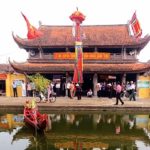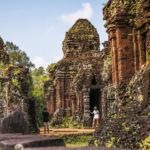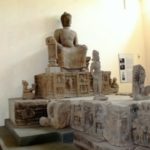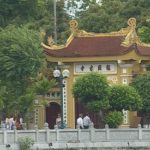India is a country that captivates visitors with its rich history and stunning ancient structures. From the bustling streets of New Delhi to the picturesque countryside, architectural wonders can be found in every corner of the nation.
India is known for its extraordinary Mughal architecture, with iconic monuments like Humayun’s Tomb in New Delhi and the Taj Mahal in Agra. The Taj Mahal, in particular, is hailed as one of the modern Seven Wonders of the World and was built by Emperor Shah Jahan as a symbol of love for his deceased wife. Additionally, there are numerous impressive forts and palaces to explore, including the Red Fort in New Delhi, Agra Fort, Jaisalmer Fort, and Amber Palace in Jaipur. These landmarks, situated near the capital, offer immersive experiences and a glimpse into India’s rich history.
| The marble tomb of the Taj Mahal, considered one of the new Seven Wonders of the World. |
India is home to a rich collection of temples that showcase the ancient architecture and cultural heritage of the country. One of the most well-known temples in New Delhi is the Akshardham temple. This Hindu complex is adorned with intricately carved white stone statues and is a must-see attraction for visitors. In addition to this, the Temple of the Sun in Konarak, Orissa, and the Temple of Khajuraho, a UNESCO site in central India, offer stunning examples of ancient temple architecture.
One particularly unique aspect of the Temple of Khajuraho is its erotic sculptures. These sculptures depict the beauty and sensuality of men and women in a tasteful and artistic manner.
Moving south, the Tirupati Balaji Temple stands out as the world’s wealthiest Hindu temple, with a staggering total asset value of $27.56 billion. This temple, dedicated to Lord Vishnu, attracts an impressive number of pilgrims, with approximately half a million daily visitors during festivals. As a result, it holds the distinction of being India’s most visited Hindu holy site.
Overall, these temples provide a glimpse into India’s rich cultural and architectural heritage, showcasing the skill and creativity of ancient craftsmen who created these magnificent structures.
One notable Sikh landmark that should not be overlooked is the Golden Temple, situated in Punjab. Adorned with donated pure gold from Sikhs, it is a sight to behold. Additionally, the step wells in the region are also worth visiting, such as the renowned “Queen’s Step Well,” Rani ki Vav in Patan, located in the northern part of Gujarat. This exceptional site has been recognized as a UNESCO World Heritage Site.
| For anyone coming to India for the first time, ancient structures are certainly the first thing that catches the eye. |
Vietnamese Buddhists frequently embark on pilgrimages to the Four Holy Places, which encompass significant sites in Buddhism. These include Bodgaya, where the Buddha achieved enlightenment; Vanarasi, where he preached; Lambini in Nepal, his birthplace; and Kushinagar, where he attained final nirvana. Additionally, one cannot ignore the remarkable Buddhist architectural marvels like the rock-carved monasteries in the Ajanta and Ellora regions near Mumbai, or the awe-inspiring Great Stupa of Sanchi, constructed by Emperor Ashoka near Bopal in central India.
The best time to visit India is during the winter season, which extends from October to the end of March. This is because the summer months, particularly in the south and north regions, can be extremely hot. However, the central highlands, such as Pune and Bangalore, offer slightly cooler temperatures during this time.
Winter in India is also notable for its vibrant festivals. The festivities kick off with the Dussehra festival in October, featuring captivating plays that retell the story of the Ramayana. This is followed by the grand celebration of Diwali, known as the festival of lights. Diwali is comparable to Vietnam’s Tet holiday, with its colorful lights, spectacular fireworks, and joyful exchange of gifts.
In February, India celebrates the Vasantpanchami festival to honor Sarasvati, the goddess of learning. Another prominent festival, Holi, takes place in March. During Holi, caste distinctions are set aside as revelers playfully throw colored powder at each other. Women also engage in the age-old tradition of painting henna on each other’s skin, not only for its aesthetic appeal, but also for its spiritual significance in conveying good wishes.
Winter is also an ideal time to explore states that may be challenging to visit during the summer, such as Rajasthan. This region organizes special camel festivals in the desert, providing unique and unforgettable experiences for travelers.
| Ancient architecture is reflected in most of the temples, richly decorated with sculptures of gods, dances and epic stories. Photo: Incredible India |
Winter is a delightful time to indulge in a steaming cup of milk tea, also known as ‘chai’, which can be found in abundance throughout India. This warm beverage serves as a comforting companion during the cold season. Indian cuisine is renowned for its bold and spicy flavors, with each dish offering a unique and aromatic masala scent. While it may take some time for Vietnamese and foreigners to fully appreciate these flavors, there are simple and delicious options to start with. One such dish is “Nan”, a soft bread made with white flour, baked in an oven, and topped with fragrant onion butter. It is traditionally served with a flavorful red bean sauce known as dal. Additionally, there are other easily accessible Indian delights to explore, such as Indian fried chicken or potato pies. Once you have developed a fondness for Indian cuisine, you can expand your culinary journey by trying Indian curries made with lamb or paneer (fresh cheese). These dishes not only boast incredible taste but also offer a nourishing and healing experience. Not to be overlooked are Indian desserts, including bean and milk cakes that resemble Vietnamese mung bean cakes but with added sweetness and creaminess. Some of these desserts even feature a delicate layer of gold or silver, which adds an elegant touch and aids in detoxification.
During your exploration of India, the rich customs of the Indian people are sure to catch your attention. Overall, Indians are known for their friendly and approachable nature. If you happen to find yourself lost, they will gladly assist you in finding your way. The customary greetings you will encounter are Namaste and Namaskar, with the latter being more formal. To add a touch of elegance, consider adding the word “Ji” at the end of your greeting. When it comes to shaking hands or presenting gifts, it is important to always use your right hand, as the left hand is primarily reserved for cleaning purposes. Additionally, when in the presence of older individuals or women, it is respectful to place your hands together and gently bow your head as a sign of reverence.
| No matter how many days or times you visit India, it will never be enough. |
It is customary to remove one’s shoes before entering a place of worship to maintain cleanliness and uphold the sanctity of the environment. The top of the head is regarded as a highly significant part of the human body, and touching it is considered impolite and insensitive, especially when dealing with infants, children, seniors, religious dignitaries, or statues of deities. Feet are considered the least clean part of the body, so it is important to never direct the soles of your feet towards another person, a temple, or a deity. To avoid this, it is advised to sit with crossed legs or kneel while inside a temple or shrine. If you need to stretch your legs, make sure to avoid sacred symbols. Lastly, it is considered disrespectful to turn your back on a religious statue.
When selecting gifts, it is advisable to refrain from using white or black wrapping paper. These colors are traditionally associated with negative or somber connotations, such as anger, evil, and funerals. Instead, opt for vibrant colors like red, blue, or green. Additionally, it is recommended to avoid gifting items made from leather, particularly pigskin.
In Indian culture, there is a unique gesture known as head bobbing that holds significant meaning in conversations. Depending on the context, this gesture signifies agreement, gratitude, or comprehension and should not be mistaken for denial. To quickly establish rapport, engaging in discussions about cricket, a popular sport in India akin to baseball, can be an effective icebreaker. Additionally, when bidding farewell, it is customary for Indians to avoid using the word “goodbye” as it may be considered too conclusive. Instead, it is common to say “see you later” to maintain a sense of optimism and openness.
In certain regions of India, it is common to encounter cows on the streets. It is advisable to remain patient and wait for them to clear the path, even if it means temporary traffic disruption. Cows hold a significant reverence in Indian culture, serving as a symbolic representation of the nurturing qualities of Mother Earth. Their milk plays a vital role in sustaining life, which has led to the prohibition of cow slaughter and beef consumption in certain states, rendering it illegal.
Traveling in India: What to Discover and Keep in Mind
India is a country that offers an endless array of experiences for travelers. No matter how many times you visit India, there will always be something new to discover. Here are a few tips to keep in mind when planning your trip:
- Embrace the diversity: India is known for its rich cultural heritage and diverse landscapes. Be prepared to encounter a wide array of traditions, languages, and cuisines as you explore different regions of the country.
- Plan your itinerary wisely: With so much to see and do, it’s important to plan your itinerary in advance to make the most of your time in India. Research popular attractions, historical sites, and natural wonders beforehand to create a well-rounded travel plan.
- Stay open-minded: India can sometimes be overwhelming for first-time visitors due to its vibrant chaos and stark contrasts. Keep an open mind and embrace the unique experiences that the country has to offer. You may encounter situations that challenge your comfort zone, but remember that these are opportunities for personal growth and cultural understanding.
- Immerse yourself in local traditions: India is a country with deep-rooted traditions and rituals. Take the time to immerse yourself in the local culture by attending festivals, visiting temples, and engaging with the locals. This will not only enrich your travel experience but also provide a deeper understanding of Indian society.
- Be mindful of your health and safety: While India is a relatively safe country to travel in, it’s always important to take precautions. Stay hydrated, eat from trusted establishments, and be cautious of your belongings. It’s also advisable to consult with a healthcare professional before your trip to ensure you have the necessary vaccinations and medications.
Remember, traveling in India is a journey of discovery and self-exploration. Embrace the beauty, chaos, and spirituality that the country has to offer, and you’re sure to create memories to last a lifetime.
Experience the thrill of a lifetime by exploring the undiscovered mystery land that remains on our planet. Don’t delay any further, gather your belongings and set forth on an unforgettable adventure.




.jpg)







